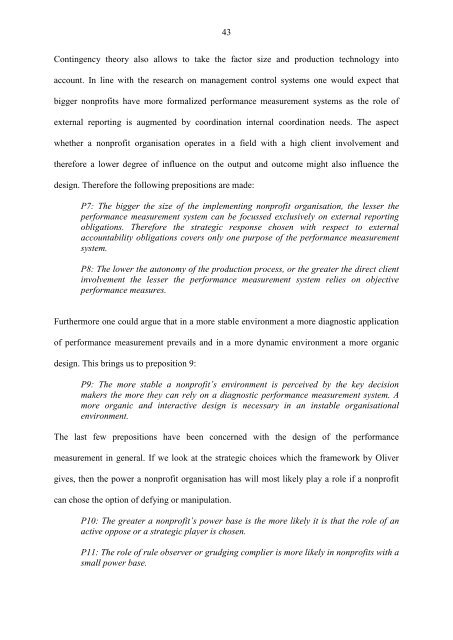Strategic responses to Performance Measurement in Nonprofit ...
Strategic responses to Performance Measurement in Nonprofit ...
Strategic responses to Performance Measurement in Nonprofit ...
Create successful ePaper yourself
Turn your PDF publications into a flip-book with our unique Google optimized e-Paper software.
43<br />
Cont<strong>in</strong>gency theory also allows <strong>to</strong> take the fac<strong>to</strong>r size and production technology <strong>in</strong><strong>to</strong><br />
account. In l<strong>in</strong>e with the research on management control systems one would expect that<br />
bigger nonprofits have more formalized performance measurement systems as the role of<br />
external report<strong>in</strong>g is augmented by coord<strong>in</strong>ation <strong>in</strong>ternal coord<strong>in</strong>ation needs. The aspect<br />
whether a nonprofit organisation operates <strong>in</strong> a field with a high client <strong>in</strong>volvement and<br />
therefore a lower degree of <strong>in</strong>fluence on the output and outcome might also <strong>in</strong>fluence the<br />
design. Therefore the follow<strong>in</strong>g prepositions are made:<br />
P7: The bigger the size of the implement<strong>in</strong>g nonprofit organisation, the lesser the<br />
performance measurement system can be focussed exclusively on external report<strong>in</strong>g<br />
obligations. Therefore the strategic response chosen with respect <strong>to</strong> external<br />
accountability obligations covers only one purpose of the performance measurement<br />
system.<br />
P8: The lower the au<strong>to</strong>nomy of the production process, or the greater the direct client<br />
<strong>in</strong>volvement the lesser the performance measurement system relies on objective<br />
performance measures.<br />
Furthermore one could argue that <strong>in</strong> a more stable environment a more diagnostic application<br />
of performance measurement prevails and <strong>in</strong> a more dynamic environment a more organic<br />
design. This br<strong>in</strong>gs us <strong>to</strong> preposition 9:<br />
P9: The more stable a nonprofit’s environment is perceived by the key decision<br />
makers the more they can rely on a diagnostic performance measurement system. A<br />
more organic and <strong>in</strong>teractive design is necessary <strong>in</strong> an <strong>in</strong>stable organisational<br />
environment.<br />
The last few prepositions have been concerned with the design of the performance<br />
measurement <strong>in</strong> general. If we look at the strategic choices which the framework by Oliver<br />
gives, then the power a nonprofit organisation has will most likely play a role if a nonprofit<br />
can chose the option of defy<strong>in</strong>g or manipulation.<br />
P10: The greater a nonprofit’s power base is the more likely it is that the role of an<br />
active oppose or a strategic player is chosen.<br />
P11: The role of rule observer or grudg<strong>in</strong>g complier is more likely <strong>in</strong> nonprofits with a<br />
small power base.
















